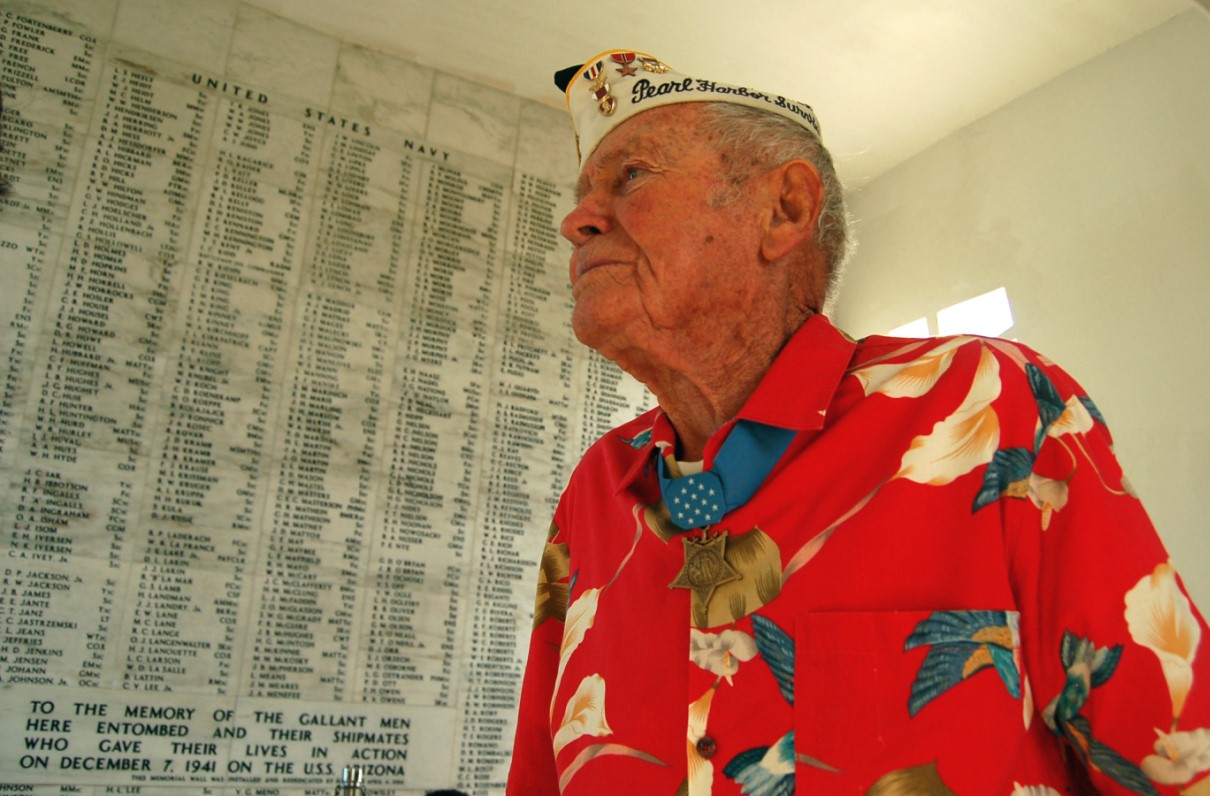(This article by Col. Charles A. Jones, USMCR (Ret), author of Pearl Harbor’s Hidden Heroes, originally appeared in the December 2021 issue of Military Officer, a magazine available to all MOAA Premium and Life members. Learn more about the magazine here; learn more about joining MOAA here.)
Sixteen men received Medals of Honor (MoHs) for actions during the Pearl Harbor attack of Dec. 7, 1941. Contrary to popular belief, these MoHs were not the first approved during the war; the first MoH approval was in February 1942 for an Army lieutenant killed in the Philippines.
Thirteen of the Pearl Harbor MoH recipients were aboard ships — five battleships (named for states) and one repair ship — on Pearl Harbor’s famous “Battleship Row.” USS California (BB-44) had four recipients:
- Warrant Officer Jackson Pharris prevented the ship from capsizing.
- Machinist’s Mate First Class Robert Scott died after refusing to abandon his space.
- Ensign Herbert Jones and Warrant Officer Thomas Reeves died maintaining ammunition supply flow for California’s antiaircraft guns.
Mortally wounded aboard USS West Virginia (BB-48) was the ship’s commanding officer, Capt. Mervyn Bennion, USN. Aboard USS Oklahoma (BB-37), Ensign Francis Flaherty and Seaman First Class James Ward were lost while remaining behind to hold lights, allowing others to escape the capsized ship. Rear Adm. Isaac Kidd and Capt. Franklin Van Valkenburgh (the ship’s commanding officer) perished on USS Arizona (BB-39), and Lt. Cmdr. Samuel Fuqua superintended crewmen’s last moments aboard Arizona.
WATCH: Paul Westermeyer, Military Historian at Marine Corps University at Quantico, Va., discusses Maj. Alan Shapley and 1st Lt. George Cannon, two officers among the many Marines cited for gallantry during the surprise attacks at Pearl Harbor and Midway on Dec. 7, 1941.
Cmdr. Cassin Young, commanding repair ship USS Vestal (AR-4), tenaciously maintained command and moved Vestal from the ship’s mooring adjacent Arizona. Aboard USS Nevada (BB-36), Warrant Officer Donald Ross refused to leave his station; Chief Boatswain Edwin Hill died attempting to drop Nevada’s anchors.
Opposite Battleship Row was “Carrier Row,” where Chief Petty Officer (Watertender) Peter Tomich died remaining in engineering spaces aboard USS Utah (BB-31), the former battleship converted to a target and gunnery ship.
North of Pearl Harbor at Kaneohe Bay, Chief Petty Officer John Finn (Aviation Ordnanceman) fired a machinegun at Japanese aircraft.
First Lt. George Cannon, USMC, mortally wounded when Japanese destroyers shelled his Midway Island command post on the evening of Dec. 7, was the only Marine Corps MoH recipient for Dec. 7.
In March 1942, President Franklin Roosevelt approved 14 Dec. 7 MoHs. He approved Finn’s MoH in June 1942. Pharris received a Navy Cross in 1942 that was upgraded to an MoH approved and presented by President Harry Truman to Pharris in 1948, the last Dec. 7 MoH awarded.
Only five recipients survived to receive their MoHs: Finn, Fuqua, Pharris, Ross, and Young. Four survived the war; Young perished in 1942’s Naval Battle of Guadalcanal.
Ships, mostly destroyer escorts, were named to honor most of these MoH recipients, and tombstones and memorials in Hawaii mark the resting places of these “hidden heroes” of Dec. 7.
Wings of World War II
Get an in-depth, interactive look at some of the most significant U.S. aircraft in the war's "arsenal of democracy."
